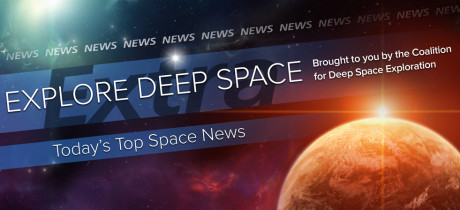In Today’s Deep Space Extra… President Trump offers encouraging words for future human space exploration in his first address to Congress.
Human Deep Space Exploration
Trump invokes dream of footprints on distant worlds
Spacepolicyonline.com (3/1): “American footprints on distant worlds are not too big to dream,” said President Trump in his first speech to Congress Tuesday night, words that appear to signal if not detail the new administration’s support for human space exploration. Further explanation should come soon when the White House submits its 2018 budget request to Congress, one that is to include spending cuts for non-defense agencies. “The sentence does not resolve any of the issues about the future of the human spaceflight program, but at least signals that the President supports the overall concept,” according to Spacepolicyonline.com.
As SpaceX unveils space tourist moon flight, NASA reacts
Space.com (2/28): NASA responds to SpaceX’s 2018 circumlunar tourist mission plan with a supportive statement as well as a reminder that it expects the Hawthorne, California, based company to meet its contractual obligations for the delivery of cargo to the International Space Station and development of a commercial launch service for the transportation of astronauts to and from the station.
A public private race to the moon
Space News (2/28): SpaceX’s bold plan to commercially loop around the moon with two tourists in late 2018 may trigger a new kind of space race, according to an op-ed from James Michael Knauf, a retired U.S. Air Force space veteran. NASA is also looking at a bold move by possibly adding two astronauts to the first joint test launch of the Space Launch System and Orion crew capsule, previously planned for late 2018 without crew and designated Exploration Mission-1 (EM-1). Agency officials say EM-1 with astronauts should launch by the end of 2019 if it is to be worth the added cost and risk. SpaceX’s Falcon Heavy, the launch vehicle for the 2018 moon mission, is to launch for the first time later this year.
Space Science
So it begins, Red Dragon delayed 2 years to 2020
Universe Today (2/28): SpaceX will wait two more years, 2020 instead of 2018, to launch its Red Dragon mission — a bid to land a Dragon spacecraft on the Martian surface with a significant science payload. Company president Gwynne Shotwell said the additional two years would enable the company to invest more resources in the crewed Dragon spacecraft it is developing for NASA’s Commercial Crew Program and the Falcon Heavy, a large commercial rocket that is to launch for the first time this year. NASA’s Commercial Crew Program is working with Boeing and SpaceX to develop U.S. commercial capabilities to transport astronauts to and from the International Space Station.
First solid sign that matter doesn’t behave like antimatter
Space.com (2/28): At the Swiss/French Large Hadron Collider, physicists are seeing differences in the way matter and antimatter behave. The findings may help to explain why matter exists in the aftermath of the big bang.
Lasers to boost communications across space
Spaceflight Insider (2/28): Two NASA spacecraft experiments planned for launch to low Earth orbit in 2019 and geostationary orbit in 2023 are to demonstrate the potential to increase deep space communications by transmitting over optical laser bandwidths. The data flow may be 10 to 100 times greater than standard radio transmissions.
This is actual science: Crystals at the Earth’s core power its magnetic field
Universe Today (2/28): Tokyo researchers offer a new explanation for the Earth’s magnetic field, a critical factor in turning away harmful space radiation and preventing the solar wind from stripping away the atmosphere. The new explanation, published in the journal Nature, links the magnetic field to the chemistry composition of the Earth’s core.
Commercial to Low Earth Orbit
Philip Levine: Space Coast should be Florida’s Silicon Valley
Florida Politics (2/28): Miami Beach Mayor Philip Levine touts Florida’s Space Coast as a 21st century Silicon Valley. “Every company involved in space should have a presence there. And every university in the state of Florida should be attracted to NASA. We need to own that space,” said Levine, who may run for Florida governor.

